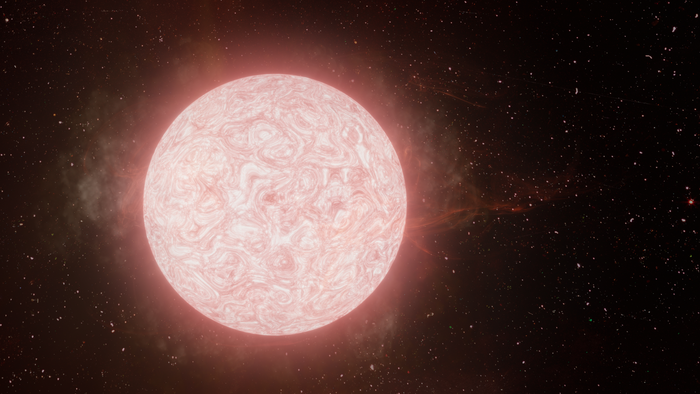For the first time in history, astronomers have imaged in real-time the striking end to a red supergiant’s life — looking at the massive star’s quick self-destruction and eventual death throes before falling into a type II supernova.
 An artist’s impression of a red supergiant star in the final year of its life emitting a tumultuous cloud of gas. This suggests at least some of these stars undergo significant internal changes before going supernova. Image Credit: W.M. Keck Observatory/Adam Makarenko.
An artist’s impression of a red supergiant star in the final year of its life emitting a tumultuous cloud of gas. This suggests at least some of these stars undergo significant internal changes before going supernova. Image Credit: W.M. Keck Observatory/Adam Makarenko.
Headed by scientists from the Northwestern University and the University of California, Berkeley (UC Berkeley), the group witnessed the red supergiant during its last 130 days leading to its fatal detonation.
The breakthrough challenges early ideas of how red supergiant stars develop just prior to exploding. Previous observations displayed that red supergiants were comparatively quiescent before their deaths — with no evidence of luminous emissions or violent eruptions. But the new observations identified bright radiation from a red supergiant in the final year before exploding.
This indicates at least a few of these stars must experience significant variations in their internal structure, which further leads to the riotous ejection of gas moments before they collapse.
This is a breakthrough in our understanding of what massive stars do moments before they die. Direct detection of pre-supernova activity in a red supergiant star has never been observed before in an ordinary type II supernova. For the first time, we watched a red supergiant star explode.
Wynn Jacobson-Galán, Study Lead Author, Northwestern University
The discovery was published on January 6th, 2022, in The Astrophysical Journal.
Even though the work was performed at Northwestern, where Jacobson-Galán was a National Science Foundation (NSF) Graduate Research Fellow, he has since moved to UC Berkeley. The co-authors of the study from Northwestern include Deanne Coppejans, Charlie Kilpatrick, Giacomo Terreran, Peter Blanchard and Lindsay DeMarchi, who are all members of Northwestern’s Center for Interdisciplinary and Exploratory Research in Astrophysics (CIERA).
Such Violent Activity was Never Confirmed
The University of Hawaiʻi Institute for AstronomyPan-STARRS on Haleakalā, Maui, initially detected the doomed massive star in summer 2020 through the enormous amount of light radiating from the red supergiant. After a couple of months, in the fall of 2020, a supernova lit the sky.
The researchers rapidly captured the strong flash and achieved the very first spectrum of the energetic explosion, called supernova 2020tlf (SN 2020tlf) utilizing the W.M. Keck Observatory’s Low-Resolution Imaging Spectrometer on Maunakea, Hawaiʻi. The data exhibited direct proof of dense circumstellar material encircling the star at the time of the explosion, probably the same gas that Pan-STARRS had imaged the red supergiant star wildly ejecting earlier in the summer.
It’s like watching a ticking time bomb. We’ve never confirmed such violent activity in a dying red supergiant star where we see it produce such a luminous emission, then collapse and combust, until now.
Raffaella Margutti, Study Senior Author and Adjunct Associate Professor, Center for Interdisciplinary and Exploratory Research in Astrophysics, Northwestern University
The team continued to track SN 2020tlf following the explosion. Depending on data collected from Keck Observatory’s Deep Imaging and Multi-Object Spectrograph and Near-Infrared Echellette Spectrograph, the scientists identified SN 2020tlf’s progenitor red supergiant star — situated in the NGC 5731 galaxy around 120 million light-years away from Earth. This was 10 times more massive compared to the sun.
Remote Possibilities
Margutti and Jacobson-Galán performed the majority of the study during their time at Northwestern, with Margutti serving as an associate professor of physics and astronomy and member of CIERA, and Jacobson-Galán as a graduate student in Margutti’s research group. Margutti is currently working as an associate professor of astronomy and astrophysics at UC Berkeley.
Northwestern’s remote access to Keck Observatory’s telescopes was essential for their research. From the Evanston campus of the University, astronomers could link with an on-site telescope operator in Hawaiʻi and select where to position the telescope. By surpassing long-distance travel to Hawaiʻi, astronomers save useful observing time — frequently catching transient events similar to supernovas, which can rapidly flare up and further vanish quickly.
This significant discovery of a red supergiant supernova is yet one more strong indication of the importance of Northwestern’s investment in access to top private telescope facilities, including the Keck Observatory. The Keck telescopes, currently the best on our planet, uniquely enable scientific advances of this caliber as CIERA researchers have shown since our Keck partnership started just a few years ago.
Vicky Kalogera, Daniel I. Linzer Distinguished University Professor, Physics and Astronomy, Weinberg College of Arts and Sciences
Vicky Kalogera is also the director of CIERA.
Margutti, Jacobson-Galán and their Northwestern co-authors are members of the Young Supernova Experiment, which utilizes the Pan-STARRS telescope to catch supernovae immediately after they explode.
Jacobson-Galán stated, “I am most excited by all of the new ‘unknowns’ that have been unlocked by this discovery. Detecting more events like SN 2020tlf will dramatically impact how we define the final months of stellar evolution, uniting observers and theorists in the quest to solve the mystery on how massive stars spend the final moments of their lives.”
The study was backed by NASA, the National Science Foundation, the Heising-Simons Foundation, the Canadian Institute for Advanced Research, the Alfred P. Sloan Foundation and VILLUM FONDEN.
Journal Reference:
Jacobson-Galán, W. V., et al. (2022) Final Moments. I. Precursor Emission, Envelope Inflation, and Enhanced Mass Loss Preceding the Luminous Type II Supernova 2020tlf. The Astrophysical Journal. doi.org/10.3847/1538-4357/ac3f3a.